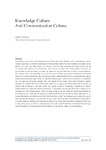Mostrar o rexistro simple do ítem
Knowledge culture and communication culture
| dc.contributor.author | Cordoban, Aurel | es_ES |
| dc.date.accessioned | 2014-10-02T12:31:24Z | |
| dc.date.available | 2014-10-02T12:31:24Z | |
| dc.date.issued | 2012 | es_ES |
| dc.identifier.citation | Culture of communication / Communication of culture, 2012: 1133-1139. ISBN: 978-84-9749-522-6 | es_ES |
| dc.identifier.isbn | 978-84-9749-522-6 | es_ES |
| dc.identifier.uri | http://hdl.handle.net/2183/13327 | |
| dc.description.abstract | [Abstract] Knowledge culture and communication culture Once that in the Western world contemporary culture became coextensive with the communication through mass media, the prior modern knowledge culture appears as a silent one. But culture is so deeply connected with communication that cultures that do not communicate cannot exist. At the limit, silent cultures are those that valorized silence, that are not covered here, or that are silent or impose the silence on the particular level or kind of communication. The modern culture of knowledge is one of these types. Thanks to quantity and diffused, the printed book is in occidental modernity the first device of mass communication. But it is composed from digital (unmotivated, arbitrary) signs. While to understand digital signs, a printed text in general, it is necessary that the signs are previously learned. The wide spread of the printed book made necessary modern education as another half of this mass media, that tries to supply the characteristic that obstacles the printed book to became a real mass media. The „silent” culture of knowledge is based on an indirect communication in which the enounce (utterance) is important, and not the enunciation (speech act or utterance act). The communicative culture of mass media is one for which the enunciation (speech act or utterance act) is important not enounce (utterance). Moreover it is based on analog signs that do not require learning but are directly perceived. Switching from „silent” to communicative culture is to switch from a pyramidal hierarchy to the network structure, from communication as transmission of information to communication as relationship construction, from text to image, from knowledge to spectacle, from soul to body, from „know yourself” to „communicate well with yourself” and from a theoretical model of sign connected/related with transmission of information to a therapeutic model of communication. | es_ES |
| dc.language.iso | eng | es_ES |
| dc.publisher | Universidade da Coruña | es_ES |
| dc.title | Knowledge culture and communication culture | es_ES |
| dc.type | info:eu-repo/semantics/conferenceObject | es_ES |
| dc.rights.access | info:eu-repo/semantics/openAccess | es_ES |






